Flying paramotors is a fun pass time that thousands of people all over the world enjoy. One question that people often ask online, when trying to get into this aerial sport, is “How can I get a paramotoring license?” However, this can be rather tricky information to find.
In the United States, the FAA classifies paramotors as ultralights. As a result, you do not need a license to fly a paramotor. However, while you do not need a license, it is advisable to take some training so you can fly and navigate safely.
Although training is suggested, you don’t need anything other than your wing, your motor, and your ambition to reach for the skies to fly.
So… Are There Rules?
Even though paramotoring does not require a license to fly, there are still rules you must follow. The FAA, or Federal Aviation Administration, has set out laws that anything flying in the United States must observe.
These laws affect everything that flies, from the lightest paraglider to the heaviest passenger jet. There are legal consequences for failing to comply with the rules and regulations. Not only that, following these laws could mean the difference between life and death.
So, what are these laws, and how do they apply to paramotors? First, we will look at the clasification of paramotors.
As far as the FAA is concerned, paramotors are an “Ultralight.” This is a subset of flying machines that are so small they technically aren’t even aircraft. At least not according to the FAA.
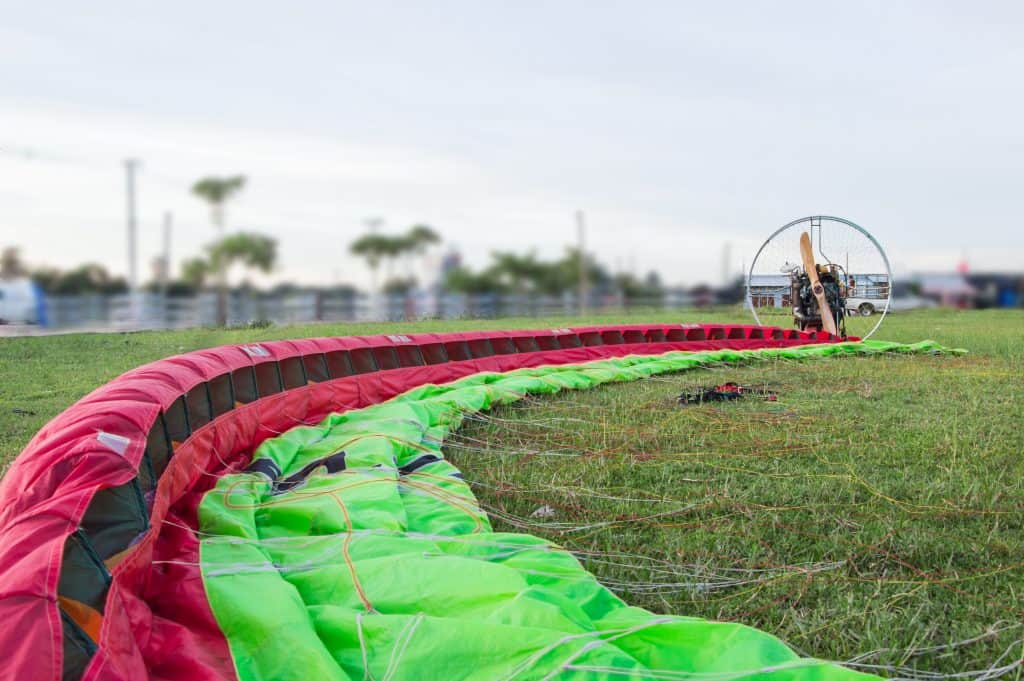
Before you begin to fly, it is essential to confirm that the machine you will be operating is, as far as the FAA sees it, an ultralight. If your machine does not qualify as an ultralight, you may need a license to fly it. So, check these qualifications before you either buy or operate any machine for the first time.
What Qualifies as an Ultralight?
Let’s take a look at the rules.
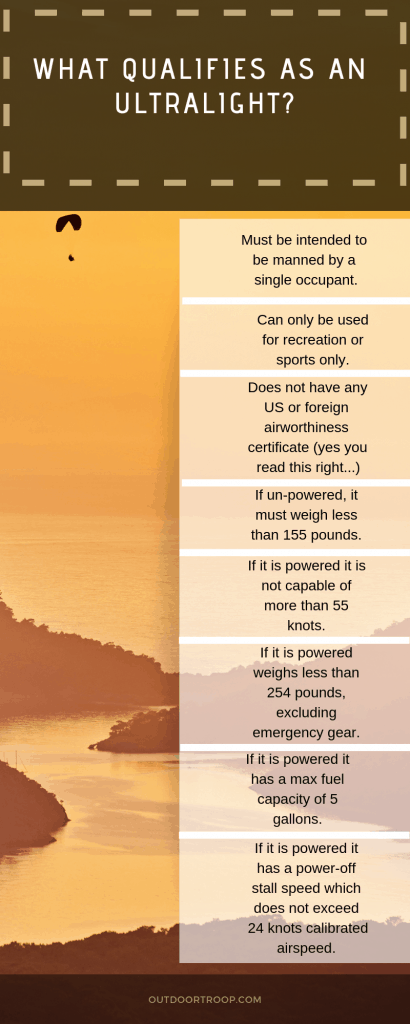
The qualifications for ultralights are straight forward and easy to understand. They are laid out by the FAA in “Part 103-Ultralight Vehicles: Subsection 103.1”
An Ultralight Must be Intended for Only One Occupant
The reasoning behind this is that those who pilot ultralights know the amount of training they have, and can accurately gauge the risk to themselves when they decide to go flying.
When the FAA was creating the classification of “Ultralight,” they intended for them to be unlicensed. However, the FAA knew that due to the nature of ultralights being unlicensed, there would be pilots who had no training that might attempt to fly with a passenger. Passengers would be quick to assume that an ultralight pilot had the proper training, and would unwittingly put themselves in danger by flying with them.
To avoid this, the FAA decided that it would be better if ultralights were limited to one person only.
Ultralights are to be Used or Intended to be Used for Recreation or Sports Purposes Only
If something is used for something other than recreation or sports, it’s not an ultralight. In other words, ultralights may not be used to fly advertisements or transport merchandise from location to location.
Limiting the use of ultralights to sports or recreation encourages pilots to fly them away from concentrations of population and other aircraft operations.
As with other sports, participants are viewed as being able to take informed, personal risks. They should not, however, take risks that could affect others, not actively participating in the activity.
The FAA believes that pilots are responsible for themselves, but as soon as other people may become actively involved, a license should be required.
Ultralights do not have Any U.S. or Foreign Airworthiness Certificate
Paramotoring, paragliding, and hang gliding (all of which are ultralights) are fun air sports, but none of the equipment is ever checked or given the green light by any government agency in the United States for airworthiness. Instead, the whole industry of ultralights is self-regulated.
There are safety ratings given by interested third parties, but these are for the benefit of the fliers. When it comes to flying ultralights, the government doesn’t care what you do, so long as you don’t put other people in danger. Giving ratings, or certifying paramotors would get the government involved in the sport, which is something that no one wants to see. Not even the government.
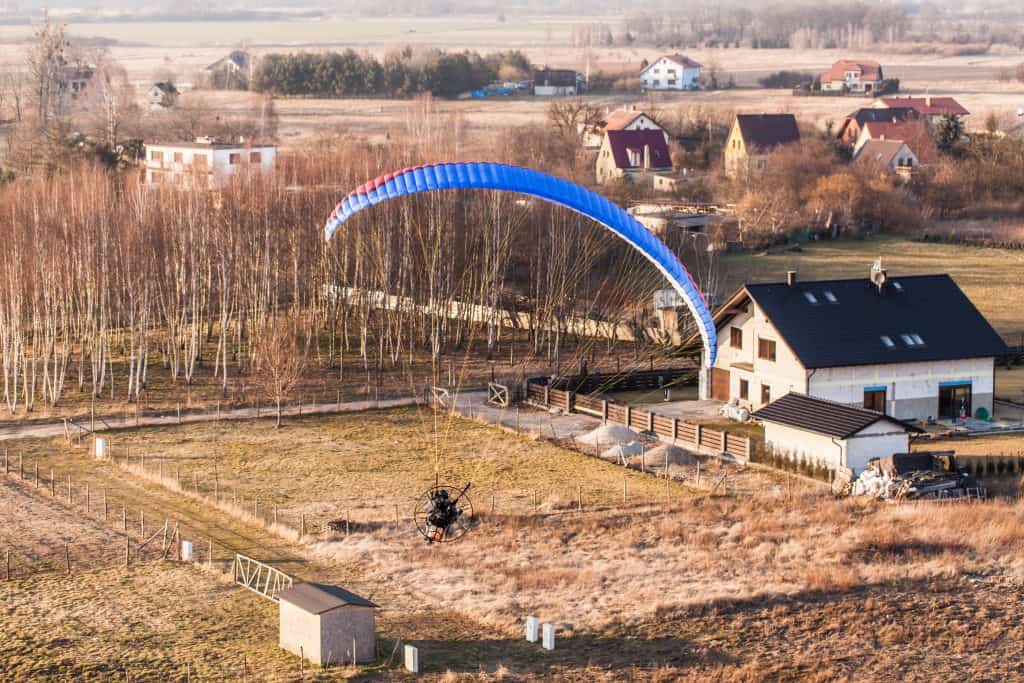
If Unpowered:
Unpowered ultralights should weigh less than 155 pounds. Unpowered ultralights are those without a motor. For example, paragliders and hang gliders.
If Powered:
Powered Ultralights or Ultralights with a motor (meaning paramotors) should have the following attributes:
- Weigh less than 254 pounds (Excluding the pilot, floats, and safety devices meant to be deployed in potentially catastrophic situations)
- Have a fuel capacity no greater than 5 U.S. gallons
- Not be capable of more than 55 knots calibrated airspeed at full power in level flight.
- Have a power-off stall speed no higher than 24 knots calibrated airspeed
If these criteria are not met, the machine is considered an aircraft, and one must have a pilots license to fly it.
Having been defined by the FAA, ultralights, and by extension, paramotors have their own set of rules and regulations. These rules and regulations separate them from aircraft in where, how, and when they should be flown.
What are these rules that regulate paramotors?
Laws for Ultralights
There are some rules that are explicitly written for ultralights. These rules all directly apply to paramotors. The laws cover questions such as where one can fly, how one should fly, and when one should fly.
Breaking these laws can put yourself and others in danger. If you are reported to the FAA, you could face various charges, and depending on the severity of the crime, you could do prison time.
So what are these laws? What can you do to keep yourself and others safe when paramotoring?
Visit our Paramotor Laws Page for more great info!
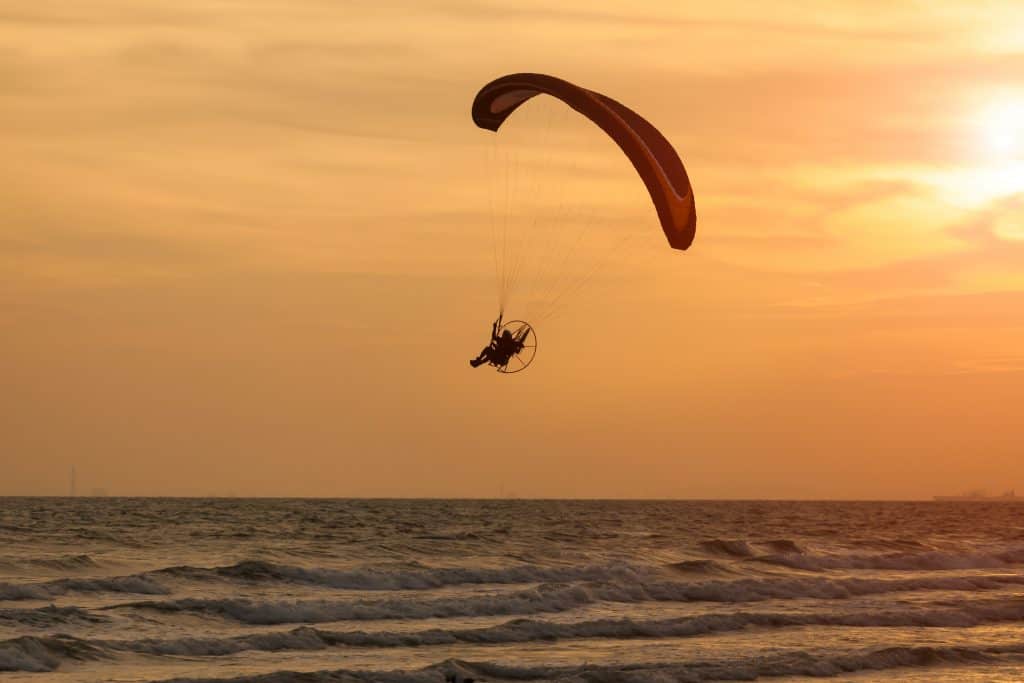
Airspace: Classifications and Permissions
Airspace is always at the forefront when considering the laws that govern paramotors. When we talk about paramotors and airspace, there’s an essential distinction between your paramotor and a legitimate aircraft.
In the eyes of the law, the military won’t view you as a pilot who is violating airspace, but rather a person who is currently invading their base, should you be encroaching on their airspace.
Airspace is something to be respected. Airports and military bases are both examples of things that will monitor their airspace carefully, so be sure to know where the local airport and military airspace borders are.
There are many different types of airspace. In America, we use the EU model of typing airspace, and divide it into different classifications:
Class A: Only Instrument Flight Rules (IFR) flying is permitted. It is the most strictly regulated airspace where pilots must comply with air traffic control instructions at all times. This airspace is mostly for major airlines and business jets. Though paramotors can fly here, it’s only in rare cases, and with explicit permission from air traffic control.
Class B: Class B is the area directly surrounding Class A airspace, and should be treated the same.
Class C: Class C airspace stretches from 19,500 feet to 60,000 feet. Both IFR and Visual Flight Rules (VFR) flying is permitted in this airspace, but pilots require clearance to enter and must comply with air traffic control instructions.
Class D: IFR and VFR flying are permitted. Air traffic control clearance is needed, and compliance with air traffic control instructions is mandatory. There is a speed limit of 250 knots if the aircraft is below 10,000 feet. (Associated with aerodromes)
Class E: IFR and VFR are both in use in Class E airspace. IFR aircraft require air traffic control clearance, and compliance with air traffic control instructions is mandatory for separation purposes. VFR traffic does not require clearance to enter class E airspace but must comply with air traffic control instructions.
Class F: Class F was redacted in 2014 and, and was disolved into either Class E, or Class G.
Class G: Aircraft and other flying machines, may fly when and where they like, but are still subject to a set of simple rules. Although there is no legal requirement to do so, many pilots notify air traffic control of their presence and intentions. Pilots take full responsibility for themselves in Class G airspace.
It is in class G airspace that you want to do your paramotor flying.
Permissions
Permission to enter airspace can be as easy as contacting air traffic control. However, for higher classes of airspace, it may be necessary to complete a form on a website or talk to a representative of the organization responsible for the airspace in which you wish to fly. It may be a lengthy process that could be denied in the end, but permission is vital to have to fly safely and legally.
If you don’t get the correct permissions to use airspace when consent is needed, you could face serious fines or prison time depending on the severity of your encroachment, and how mad you’ve gotten higher-ups.
NOTAMS
Another thing to consider is checking the Notices to Airmen (or NOTAMS), which can detail events that could be happening in a particular area.
A NOTAM is a notice containing information essential to personnel concerned with flight operations but not known far enough in advance to be publicized by other means. It states the abnormal status of a component of the National Airspace System (NAS) – not the normal status.
Be sure to check for NOTAMs when going flying, even if you’ve been given permissions in the past. Things could change due to unforeseen circumstances.
There’s nothing worse than getting permission to fly in airport airspace, just to be yelled at by air traffic control to “Get out of our airspace!” as they’re “trying to land a plane redirected because of bad weather!”, and that “Your being in the airspace is making the operation very difficult!”, and that “You should have checked the NOTAMs!”
Don’t Fly:
When You Can’t See the Ground
There are rules that paramotors must follow concerning visibility. These rules exist for pretty obvious reasons. You don’t want to collide with anything accidentally and injure yourself or others.
One FAA rule is that Paramotorists should have some form of ground reference at all times while in flight. This means that you should be able to see the ground at any given time during your flight.
Visual contact with the ground could be obstructed in several different ways. One way is that a thick layer of fog could be covering the ground.
Another way that visual contact with the ground could be obstructed is if you are flying above a solid layer of clouds.
Visual contact with the ground at all times is useful for orientation, but also for avoiding obstacles that are hiding just past the cover. In most situations where you cannot see the ground, it is likely a weather condition that should be keeping you from the skies.
For example
- Thick fog can hide trees, poles, and electric wires that could give you a nasty surprise. And clouds the tightly bunched up that you can’t find a hole means potential rain.
- Rain can cause something called “parachutal stall” when paramotoring, and should be avoided at all costs.
Near the Clouds
Speaking of clouds, paramotorists are not legally allowed to fly into or through clouds. This is because it disorients the pilot and reduces ground visibility, and there is the potential for a mid-air collision (it’s happened before).
Follow this chart to determine how close to the clouds you should allow yourself to get:
| Airspace | Flight Visibility | Distance From Clouds |
| Class A | Not applicable | Not applicable |
| Class B | 3 statute miles | Clear of Clouds |
| Class C | 3 statute miles | 500 feet below, 1,000 feet above, 2,000 feet horizontal |
| Class D | 3 statute miles | 500 feet below, 1,000 feet above, 2,000 feet horizontal |
| Class E – Less than 10,000 feet MSL | 3 statute miles | 500 feet below, 1,000 feet above, 2,000 feet horizontal |
| Class E – At or above 10,000 feet MSL | 5 statute miles | 1,000 feet below, 1,000 feet above, 1 statute mile horizontal |
| Class G – 1,200 feet or less above the surface (regardless of MSL altitude) | 1 statute mile | Clear of clouds |
| Class G – More than 1,200 feet above the surface but less than 10,000 feet MSL | 1 statute mile | 500 feet below, 1,000 feet above, 2,000 feet horizontal |
| Class G – More than 1,200 feet above the surface and at or above 10,000 feet MSL | 5 statute miles | 1,000 feet below, 1,000 feet above, 1 statute mile horizontal |
At Night
Night flying is dangerous for many of the same reasons that flying in fog is dangerous. Pilots are more likely to fly into wires, trees, or other obstacles that are hard to see at night.
As a result, flying at night when vision is severely limited is strictly prohibited. You cannot fly more than 30 minutes before sunrise or 30 minutes after sunset.
Places to Avoid
Paramotorists are not permitted to fly in densely populated/condense towns or cities. This rule is commonly ignored in more rural areas, but residential, commercial, and industrial areas, where buildings are more common, are to be avoided when flying a paramotor.
Chances are that no one is going to be too upset if you are taking off from a field that’s near your house. The thing that will actually get you into trouble though is paramotoring too close to an event.
For example:
The Riddick Bowe VS Evander Holyfield fight on November 13, 1992, in Las Vegas, Nevada was interrupted in the 7th round as a paramotorists crash-landed into the boxing ring, and fell into the crowd.
James Miller, the paramotorist, was savagely beaten by the crowd and was sent to the hospital as his paramotor was torn apart as “souvenirs” by the crowd.
Hopefully this teaches you two valuable lessons-
One: Don’t drop into a heavy weight boxing match with an ultralight and
Two: Don’t fly in congested areas or near big events.
Who Has the Right of Way?
In the world of air sports, the possibility of collision with another pilot is slim, but there are times when two crafts are on an intercept course.
When in this conundrum, the important thing to remember when flying paramotors is this-
You need to run from everything.
If you encounter a big plane, it has the right of way except for a few situations, and you need to steer clear of it.
Paramotors are more maneuverable than paragliders, or hot air balloons as well, so it’s up to paramotors to avoid collision with them.
When flying a paramotor, it’s safe to assume that it’s your responsibility to get out of the way.
In cases where you look like you might run into someone, remember:
“On the right, in the right.”
What is meant by this is that in the case of a head-on collision becoming a possibility, both pilots should veer to their respective rights. This should help avoid collisions.
If there is a case where one craft is overtaking another craft, the overtaking craft will veer to the right to avoid collision.
If two crafts are approaching on the same altitude, the one on the right, like we stated before has the right of way.
Another good rule for public flying is to keep landmarks, coastlines, or anything of interest on your left.
If you, however, are not a fan of public flying, it’s not a big deal. It’s a big sky out there. Knowing the basics of how to avoid a mid-air collision is something that even an unlicensed paramotor pilot should know though.
Laws Vs Reality
Often, when reading legislation and looking at the reality of the world around us, we see conflicts. For instance, earlier, we discussed how in order for a flying machine to be considered an ultralight, it must be built to hold only one occupant.
Yet tandem flights, where two people are on the same paramotor, are a thing that is not only legal but encouraged by the community as a safe and cheap way to get into paramotoring. What’s up with that?
Another question that some people have when it comes to paramotors and accountability is this, who is going to check to make sure your paramotor is up to standards?
In fact, how is anyone going to catch you breaking any of these rules?
In the world of paramotoring, snitching is beneficial. Let’s get into it.
Reporting Screwed Up Stuff
When flying paramotors, it’s important to keep the community self accountable. If paramotors become a nuisance, the government would have to step in with it’s own regulations and programs.
Someone who is being unsafe, flying where they are not allowed, or is otherwise causing trouble should be reported to the FAA. However, it’s also important to realize that sometimes, reporting someone for something without knowing the details of the laws can make you look foolish.
Troublemakers can also be caught by air traffic control. They’re surprisingly adept at finding and fining people who violate the laws of the air.
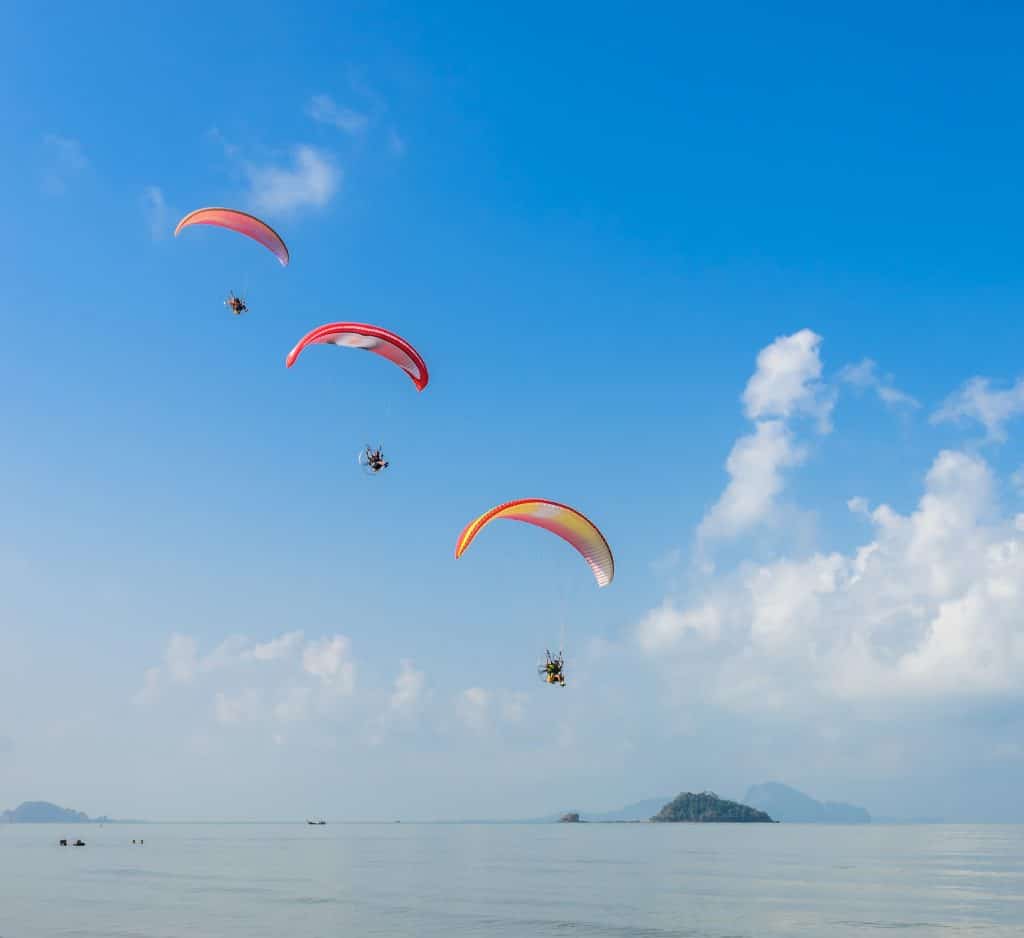
Certifications for Paramotors: What do they mean?
If we’re being completely honest here, the FAA doesn’t actually care if your paramotor is safe or not. No ultralights have mandatory government testing for products. When I say the world of paramotoring is self maintained, I mean it.
So long as they qualify as an ultralight, paramotors can be as safely or unsafely tricked out as you want.
There are third parties however who rate paramotors on a safety scale, and certify them in a sense. People tend to trust the ratings that these paramotor experts give to these paramotors. However, these ratings are not ‘official’, in the sense that they have no actual standing in the eyes of the government. If you buy a paramotor, it’s best to look online at its rating.
There are festivals which are held to certain standards as well, where only people with a certain rating of paramotor can attend in order to avoid accident or injury. They simply check to be sure the paramotor is either a trusted brand or something just as good/better.
In the world of paramotoring, it won’t be the government regulating the sport, but your peers who want to maintain the good name of paramotoring, using the government as the enforcer of the rules that they all agree to follow.
Sports Pilot License
One way to enhance your paramotoring experience is to spend some time getting a sports pilot’s license.
Sports Pilot Licenses were created by the FAA in order to provide the extra training needed to be trusted with carrying a passenger.
With the Sports Pilot License, you can fly machines that are classified above ultralight, titled “Light Sport Aircraft”.
For instance, you can become a “Tandem Flight Instructor”, meaning that you are permitted to fly paramotors that can seat two people for the purpose of training. These paramotors don’t fit into the Ultralight category but instead, fit into the Light Sport Aircraft Category, which is alright because with a Sports Pilot License, you can legally fly them.
Different rules apply to people who have a Sports Pilot License. They have a greater freedom to fly paramotors that don’t quite fit into the standard ultralight classification.
With the Sports Pilot License comes a greater responsibility though. Getting one doesn’t take as much time as a full pilot’s license, but there is still a significant amount of training and time that goes into receiving a Sports Pilot License.
Keep in mind, this is not a “paramotoring license”, but something that gives a government seal of approval to trainers and others who should be trusted in their skill and ability.
Paramotoring is unlicensed, but in order to keep it that way, we need to be responsible, and govern ourselves as a paramotoring community. Be smart about what you do on a paramotor. You represent the whole community when you take flight.
Additional Questions
How Long does Paramotoring take to Learn?
Paramotoring school lasts only about 1-2 weeks, but by the end of it, you should be able to:
- Maintain a wing,
- Maintain a motor,
- Control the wing on the ground,
- and go for a short flight.
Any additional training is a reaffirmation of these skills.
Is there an Age Limit for Paramotoring?
While there is not an official age limit to paramotoring, most piloting schools will not take on any students younger than 14 years old. Similarly, there is no upper age limit either.
Final Thoughts
So there you have it. You do not need a license to pilot a paramotor in the United States because the FAA classes them as ultralights and not aircraft.
This technical distinction is important as it regulates in which classes of airspace you can fly, in what conditions, and at what times.
While you do not need a license, there are rules and regulations that govern flying a paramotor. Breaking these rules, or the laws governing airspace can see you fined, prosecuted, or even jailed.
Taking some voluntary training will help to keep you, other people in the air, and other people on the ground, safe.
